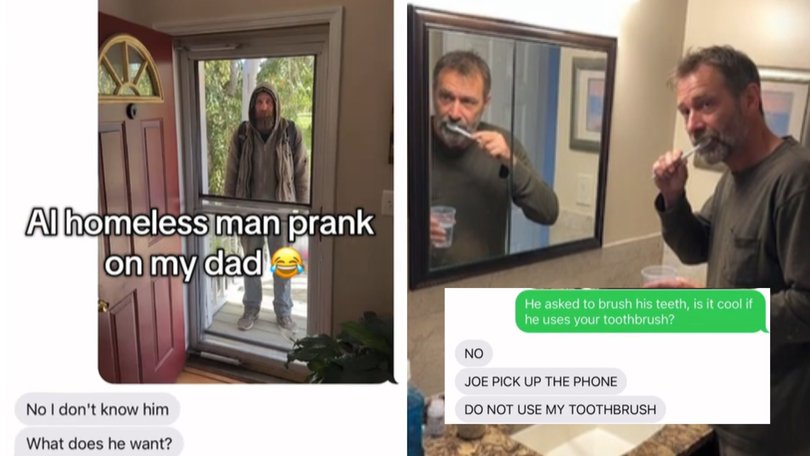THE NEW YORK TIMES: Police warn against pranking people with AI images of homeless intruder

Police departments in at least four states are warning about an online trend in which people are using images generated by artificial intelligence to trick friends and relatives into believing that a homeless man had invaded their homes.
They say that the “disturbing” and “dangerous” prank causes panic and wastes public resources, as it can result in police officers responding to nonexistent emergencies.
The stunt received attention after hundreds of videos with hashtags like #aihomelessprank and #homelessmanprank circulated on TikTok; at least one video raked in over 1 million views.
Sign up to The Nightly's newsletters.
Get the first look at the digital newspaper, curated daily stories and breaking headlines delivered to your inbox.
By continuing you agree to our Terms and Privacy Policy.The prank works like this: A person texts a friend or family member an AI-generated picture of a homeless man knocking at the door, eating in the kitchen or lying in bed at the home.
The sender often claims that the man had said he was an acquaintance and had asked to come inside or for food.
Then, the person who receives the picture reacts, often with concern or panic. The prankster then includes the reaction in a video posted to social media.
The pranks can cause panic, waste resources and are dangerous, according to police agencies in Massachusetts, Michigan, New York and Wisconsin. The police said they had responded to multiple calls of home intrusions, only for officers dispatched to the scene to learn that the break-ins were fake.
“There are so many scenarios that could go wrong,” said Capt. John Burke of the Salem Police Department in Massachusetts.
If a worried family member calls to report an intruder with a weapon, armed officers dispatched to the scene could confront an unaware house occupant or neighbour, creating a potentially dangerous situation, he said.
Causing panic and distress to an older person could prompt a medical complication, he added.
The Shawano County Sheriff’s Office in Wisconsin, the Yonkers Police Department in New York and the West Bloomfield Police Department in Michigan all said in their statements that the prank “isn’t funny” and could be dangerous for both the police and the public.
“It’s a real safety risk for officers who are responding and for the family members who are home if our officers get there before the prank is revealed,” the Yonkers Police Department said in its statement.
The prank also “dehumanizes the homeless,” the Salem Police Department said in its statement. It noted that someone who causes emergency services to be dispatched to a nonexistent emergency could face a prison term of up to 2 1/2 years or a fine of up to $1,000.
TikTok did not comment directly on the prank but has said that creators are required to label content generated by AI and that the company was aggressive in removing content that violates guidelines.
AI has been used by women in a similar prank in which images of muscular, shirtless plumbers are generated in pictures of bathrooms and kitchens to elicit jealous reactions from boyfriends.
Videos of the pranks involving homeless men and shirtless plumbers have been shared hundreds of times and have generated thousands of comments. Tutorials on how to use AI to create those images have also gained traction online.
As AI hoaxes become more common, law enforcement agencies will need to find a new way to classify and discipline people who generate false reports, the police say.
“I look at it like a new version of swatting,” Burke of the Salem Police Department said. “It’s a really, really terrible idea.”
This article originally appeared in The New York Times.
© 2025 The New York Times Company
Originally published on The New York Times
